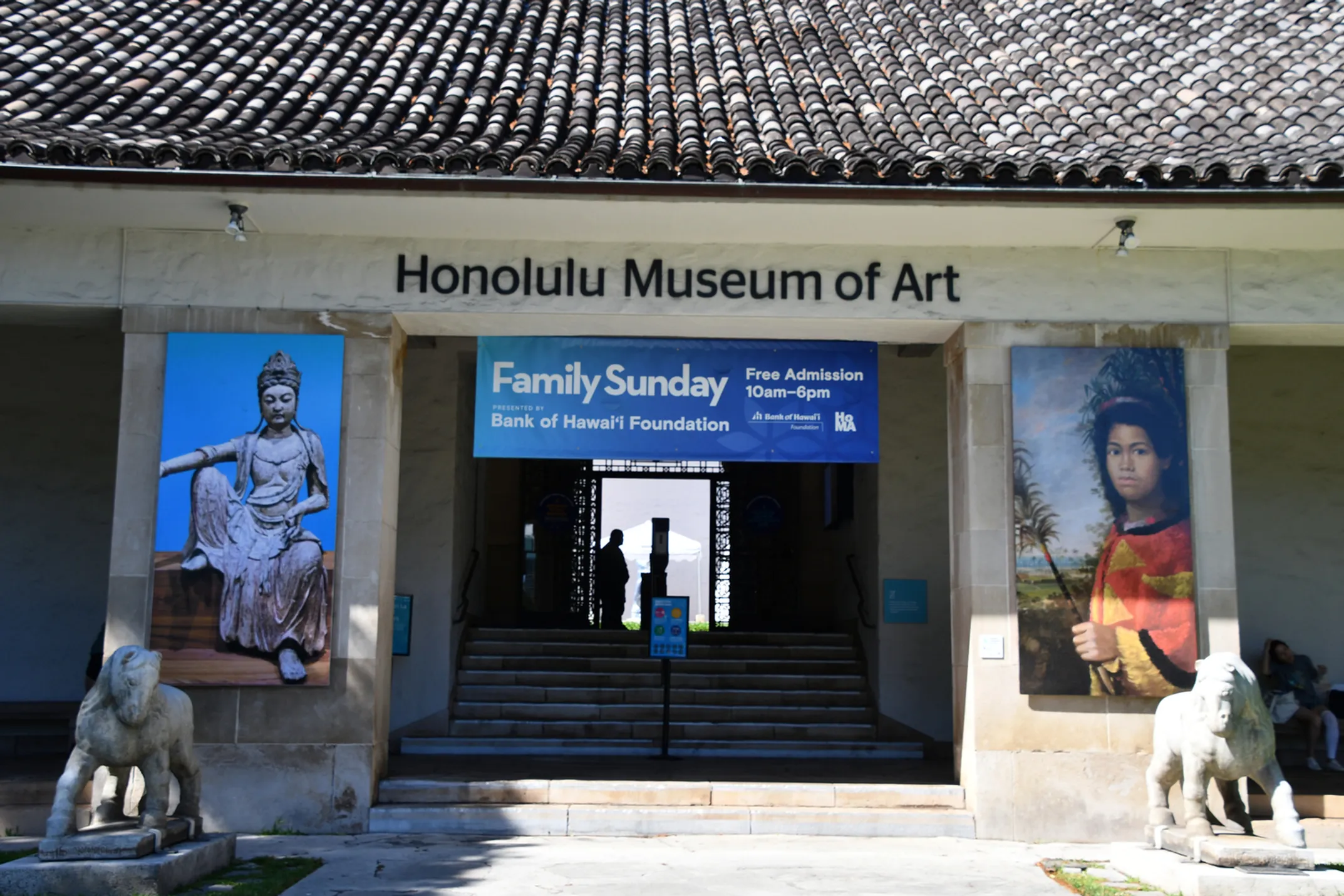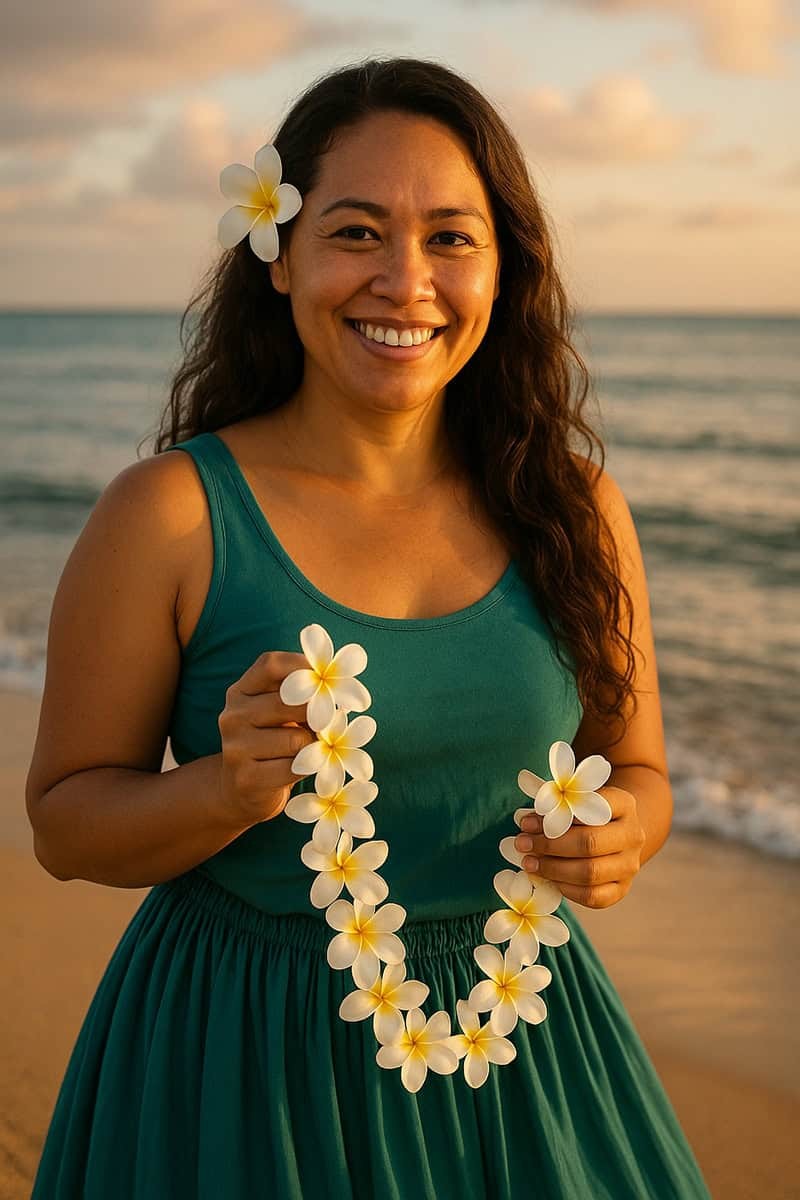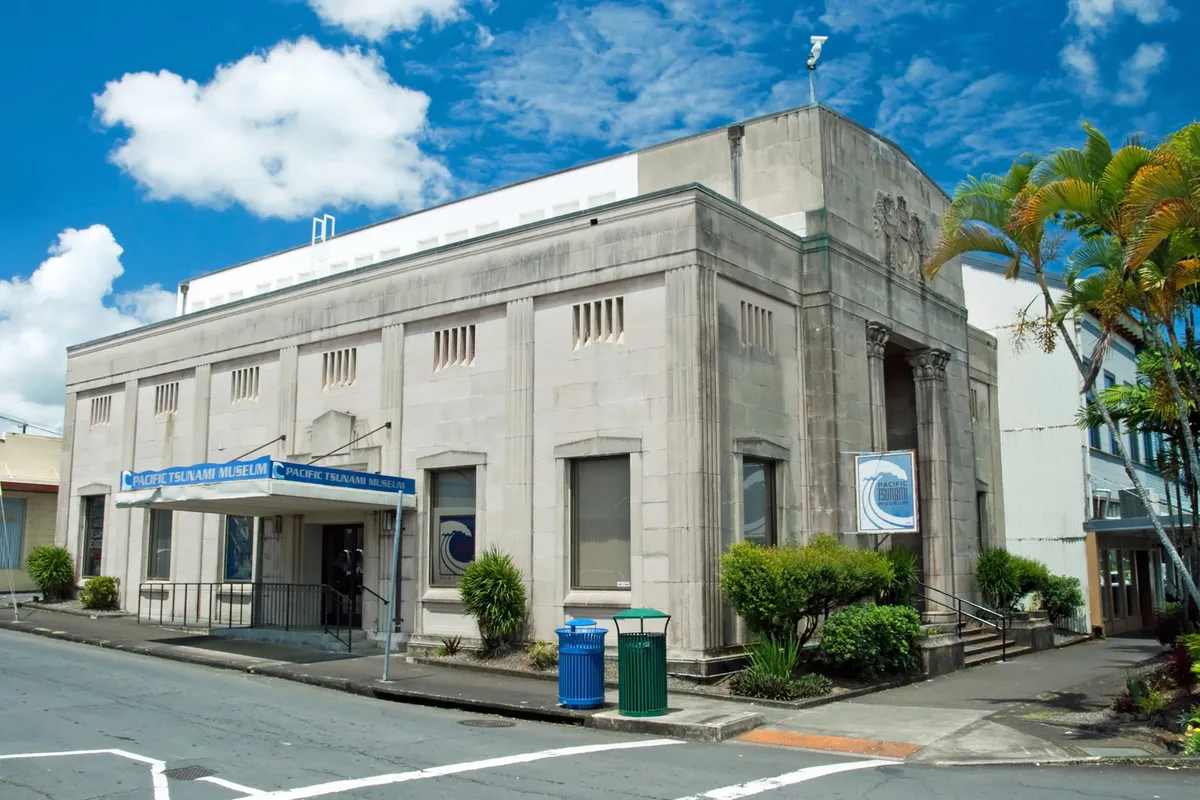

Part I: Oʻahu – The Gathering Place of History and Art
Where the stories of the Hawaiian Kingdom, world conflict, and vibrant multicultural art come together

Written by
Leilani AkoOʻahu is rightfully called "The Gathering Place." For centuries, it has been the center of power, business, and culture in the islands. Here the stories of the Hawaiian Kingdom, the chaos of world conflict, and a vibrant, multicultural art scene come together. Our museum journey begins in the historic heart of Honolulu. A district that holds the legacy of our last monarchs.
The Royal Story: A Tale of Two Palaces
To understand Hawaiʻi, you must understand our monarchy. Two palaces in Honolulu tell this powerful story. One of a forward-thinking, free nation. The other of a peaceful, personal retreat.
ʻIolani Palace: A Beacon of Power and Sorrow
Standing proudly in downtown Honolulu, ʻIolani Palace is not just a building. It is the spiritual and physical multicultural center of Hawaiʻi. As the only official royal home on U.S. soil, it is a strong symbol of our kingdom's proud, free past.
Built in 1882 by our last king, Kalākaua, known as the "Merrie Monarch" for bringing back Hawaiian culture, the palace was amazing for its time. It had Hawaiʻi's first electric lights, flush toilets, and an internal phone system. This showed a level of technology that matched the great houses of Europe and even the White House.

ʻIolani Palace stands as a testament to Hawaiian sovereignty and innovation, featuring architecture that blended European grandeur with Hawaiian sensibilities
A tour through its carefully restored rooms brings back the grand balls and world politics that once happened here. The grand hall with its beautiful koa staircase. The rich throne room. The state dining room. Yet the palace also holds deep sadness. Here King Kalākaua's sister and successor, Queen Liliʻuokalani, was held prisoner in an upstairs room. This happened after the illegal overthrow of the Hawaiian monarchy in 1893. The palace stands as a living restoration. A testament to both the heights of Hawaiian innovation and the pain of its loss.
Tours & Details: ʻIolani Palace
ʻIolani Palace offers several ways to experience its history. The guided and self-led audio tours take you through the first and second floors and the basement galleries. These house the royal crowns and jewelry. For a deeper look, special tours like the Kalākaua Legacy Tour focus on the king's life. The exclusive Royal Legacy Tour takes small groups beyond the ropes for a close look at precious objects. You can even find a Chamberlain's Tour for a unique staff view.
Beyond the main tour, don't miss the hidden details. The four tiny Tower Rooms tucked away on the third floor. The queen's private bath. The detailed quilt she created during her imprisonment. Each stitch tells a story of her pain and pride.
The palace is open Tuesday through Saturday from 9 a.m. to 4 p.m. Tickets should be booked online in advance. Prices are around $32.95 for adults, with kamaʻāina (local resident) and military discounts available. Remember to dress with respect. This is a sacred place. Personal strollers are not allowed, though the palace provides them.
Queen Emma Summer Palace (Hānaiakamalama): A Royal Retreat
A short drive from the political center of Honolulu sits Hānaiakamalama. Nestled in the cool, lush Nuʻuanu Valley, this was the beloved summer palace of Queen Emma, her husband King Kamehameha IV, and their son, Prince Albert Edward. Built in 1848 with a frame shipped all the way from Boston, its Greek Revival style offers a charming contrast to the American Florentine style of ʻIolani. This was their escape. A place of peace away from the demands of court life.
The home is managed by the Daughters of Hawaiʻi. A group of women who, in 1915, saved the palace from being torn down to make way for a baseball field. Inside, you'll find a personal collection of the queen's belongings, royal antiques, and gifts from dignitaries like her godmother, Queen Victoria of England. This includes the koa wood cradle of the young prince whose tragic death cast a shadow over the family.
Tours & Details: Queen Emma Summer Palace
The palace is open Wednesday through Saturday from 10 a.m. to 3:30 p.m. Both self-guided and docent-led tours are available. Adult tickets range from about $14 to $20. Because it is a historic 19th-century home, access can be hard for those with trouble climbing stairs. It's wise to call ahead to make arrangements.
The Keeper of the Pacific: Bishop Museum
If there is one place that holds the complete story of Hawaiʻi and the vast Pacific, it is the Bernice Pauahi Bishop Museum. Founded in 1889 by Charles Reed Bishop to house the priceless heirlooms of his late wife, Princess Bernice Pauahi Bishop—the last royal descendant of the Kamehameha dynasty—the museum has grown into the state's premier place for natural and cultural history. With a collection of over 25 million historical, cultural, and natural treasures, it is a place of immense knowledge and discovery.
A visit here is a multi-faceted journey. The magnificent Hawaiian Hall takes you through three realms of Hawaiian cosmology. The ground floor, Kai Ākea, represents the world of the gods and ancient legends, where a life-size replica of a sperm whale hangs from the ceiling. The second floor, Wao Kanaka, is the realm of people, showcasing daily life, work, and the importance of nature. The third floor, Wao Lani, is the realm of the gods and the aliʻi, where you learn about the monarchy and key moments in our history.
Beyond Hawaiian Hall, the Pacific Hall explores the wider expanse of Oceania. It connects the diverse yet linked cultures of the Pacific through model canoes, contemporary art, and archaeological findings. For families, the Richard T. Mamiya Science Adventure Center is a must. This interactive space brings science to life, with a giant model volcano that "erupts" and hands-on exhibits on volcanology, oceanography, and Hawaii's unique biodiversity. The daily lava-melting demonstration is a crowd favorite. Be sure to get a seat early.
The J. Watumull Planetarium offers captivating shows that connect modern astronomy with the ancient Polynesian art of wayfinding by the stars. The museum also hosts world-class traveling exhibits, like the current "Expedition Dinosaur," ensuring there's always something new to see.
What many visitors don't see is the museum's role as a world-class research place. Behind the public galleries lie vast collections vital to global science. An archaeology department with the world's largest collection of Pacific artifacts. A botany department holding specimens from Captain Cook's voyages. The Pacific Center for Molecular Biodiversity, which cryo-preserves the DNA of threatened and extinct species. The Bishop Museum isn't just preserving the past. It's actively decoding it for the future.
Tours & Details: Bishop Museum
The museum is open daily from 9 a.m. to 5 p.m. Ticket prices were updated in 2025. General admission for adults is around $38.95, with significant discounts for kamaʻāina and military members. The museum is also a proud participant in the Museums for All program, offering free admission for SNAP EBT cardholders. To avoid the largest crowds, plan your visit for a weekday afternoon after the school groups have departed.
A Day of Remembrance: Navigating the Pearl Harbor Historic Sites
On December 7, 1941, the course of world history changed on the shores of Oʻahu. Today, Pearl Harbor is a place of solemn remembrance, an active naval base, and a collection of five distinct historic sites that tell the story of the attack and its aftermath. Visiting can be a powerful and emotional experience, but the logistics can be complex. Here is a straightforward guide to help you plan your day.
The entire complex is anchored by the Pearl Harbor National Memorial, operated by the National Park Service. This is your entry point.
The Core Experience (Free, but Reservations Required)
USS Arizona Memorial
This is the final resting place for 1,177 crewmen who lost their lives aboard the sunken battleship. Visiting is free, but you must have a timed reservation, which can be booked online at recreation.gov for a $1 service fee. Tickets are released up to 8 weeks in advance and go quickly. The program includes a powerful 23-minute documentary and a Navy-operated boat shuttle to the serene white memorial that straddles the submerged hull.
USS Oklahoma and USS Utah Memorials
These are also free sites honoring the hundreds of men who died on those ships. They are located on Ford Island and are typically accessed via the shuttle bus.
The Partner Museums (Paid Admission)
Battleship Missouri Memorial
Walk the decks of the ship where Japan formally surrendered, ending World War II. It's a powerful bookend to the story that began with the Arizona. General admission is about $34.99.
Pacific Fleet Submarine Museum
Home of the USS Bowfin, a WWII submarine nicknamed the "Pearl Harbor Avenger." The tour takes you through the tight quarters of the sub. Admission is about $21.99.
Pearl Harbor Aviation Museum
A must for aviation and history enthusiasts. Located in historic hangars on Ford Island that survived the attack (you can still see bullet holes in the windows), the museum features over 50 aircraft, from a P-40 Warhawk to modern jets. The interactive flight simulators are a hit with all ages. The Top of the Tower Tour offers an unforgettable 360-degree view of the entire battlefield from the newly opened historic control tower. General admission is about $27.99 online.
Leilani's Foolproof Plan for Visiting Pearl Harbor
- Book the Arizona First: Go to recreation.gov weeks or even months in advance and secure your free, timed ticket for the USS Arizona Memorial. This will be the anchor for your entire day.
- Decide on Other Sites: Determine which of the partner museums you want to see. You can buy individual tickets or purchase the Passport to Pearl Harbor, which bundles admission to the Missouri, the Submarine Museum, and the Aviation Museum.
- Crucial Tip: The Passport does not include your reserved time for the Arizona Memorial.
- Plan Your Arrival: The full experience can take up to 8 hours. Arrive early, especially if you haven't pre-paid for parking ($7/day), as the lot fills up. When using a GPS, navigate to the "Pearl Harbor National Memorial," not just "Pearl Harbor," to avoid ending up at the active military base gate.
- The No-Bag Policy: This is the most important rule. You cannot bring in any bag that offers concealment—no purses, backpacks, camera bags, etc. Small clutches are permitted. A bag storage facility is available for a fee, but lines can be long. Leave everything in your car, bringing only your wallet, phone, camera (without a bag), and a water bottle.
- Dress for the Day: This is a place of reverence. Dress respectfully (shirts and shoes required, no swimsuits) and practically. Wear comfortable shoes and bring sun protection, as much of the site is outdoors.
Oʻahu's Art Scene & Niche Museums
Beyond the monumental historical sites, Oʻahu is home to a thriving and diverse arts and culture scene. Museums that hold treasures from around the globe and celebrate the incredible talent of our local artists.
Honolulu Museum of Art (HoMA)
The state's largest fine arts museum is a beautiful oasis of art and culture. Galleries built around serene, open-air courtyards. Its collection is world-class, boasting one of America's finest assemblages of Asian art, including the James A. Michener collection of Japanese ukiyo-e woodblock prints. The European collection is equally impressive, with works by masters like Van Gogh, Monet, Gauguin, and Picasso. The Arts of Hawaiʻi gallery provides a stunning overview of our islands' artistic traditions.

The Honolulu Museum of Art welcomes visitors with its blend of Asian and Western art, showcasing Hawaii's unique position as a cultural crossroads
Insider Tip: HoMA is a fantastic budget-friendly option. Admission is always free for children 18 and under. For Hawaiʻi residents, the third Sunday of every month is Community Day, with free admission for all kamaʻāina. The museum also participates in the Museums for All program, offering free admission to SNAP/EBT cardholders.
Shangri La Museum of Islamic Art, Culture & Design
This is one of Oʻahu's most exclusive and breathtaking experiences. Shangri La was the cliffside home of tobacco heiress and philanthropist Doris Duke, who fell in love with Islamic art during her travels and built this architectural masterpiece to house her collection. With intricate tilework from Iran, a room from Damascus, and stunning seaside views, it is an unforgettable journey into another world.
How to Visit: Tours are limited and must be booked in advance through the Honolulu Museum of Art, as all tours begin and end there. Tickets are released quarterly and sell out very quickly, so plan ahead.
Capitol Modern (formerly HiSAM)
Located in the beautiful, historic former YMCA building in downtown Honolulu, Capitol Modern is the "People's Museum". It is operated by the Hawaiʻi State Foundation on Culture and the Arts and showcases the incredible contemporary art of artists with a connection to Hawaiʻi. Best of all, admission is always free, making it a perfect stop for a quick and inspiring dose of local culture.
A Roundup of Oʻahu's Other Stories
Hawaii's Plantation Village
In Waipahu, this outdoor museum offers guided tours through an authentic re-creation of a sugar plantation community. It highlights the diverse cultures—Chinese, Japanese, Filipino, Portuguese, and more—that shaped modern Hawaiʻi. Tours are by appointment only.
U.S. Army Museum of Hawaii
Housed within a massive former coastal artillery battery at Fort DeRussy in Waikiki, this museum is also free to the public and traces Hawaii's military history from ancient warriors to the present day.
Hawaii Children's Discovery Center
The ultimate interactive museum for young keiki (children), this Kakaʻako center is a place for hands-on learning and play, featuring fantastic exhibits like a "Rainforest Adventure."
Unique Stops
For something truly different, visit the serene Byodo-In Temple in the Valley of the Temples Memorial Park, a stunning replica of a nearly 1,000-year-old temple in Uji, Japan. Or, for a quirky Waikiki stop, the Lucoral Museum offers a look at gems and corals and even hosts jewelry-making classes.
Continue Your Museum Journey
Explore more of Hawaii's incredible museums across the other islands
📍 On This Page
🕐 Museum Hours
- ʻIolani Palace Tue-Sat: 9am-4pm
- Queen Emma Palace Wed-Sat: 10am-3:30pm
- Bishop Museum Daily: 9am-5pm
- Pearl Harbor Daily: 7am-5pm
- HoMA Tue-Sun: 10am-6pm
💰 Free Museums
- Capitol Modern (always free)
- U.S. Army Museum
- Pearl Harbor Visitor Center
- USS Arizona Memorial (reservation required)
📝 Booking Tips
Book 8 weeks in advance
Quarterly release, sells out fast
Online booking recommended

